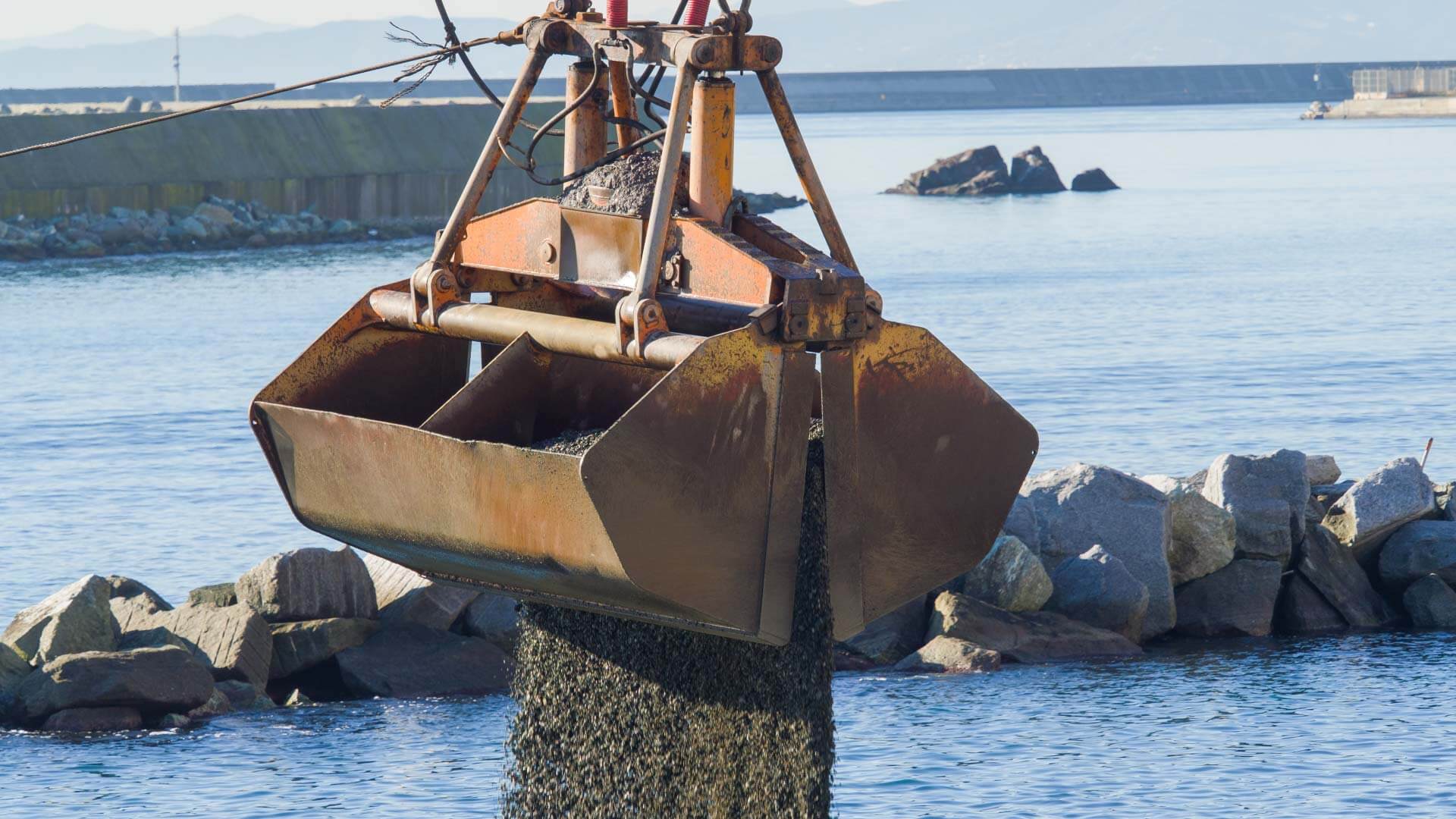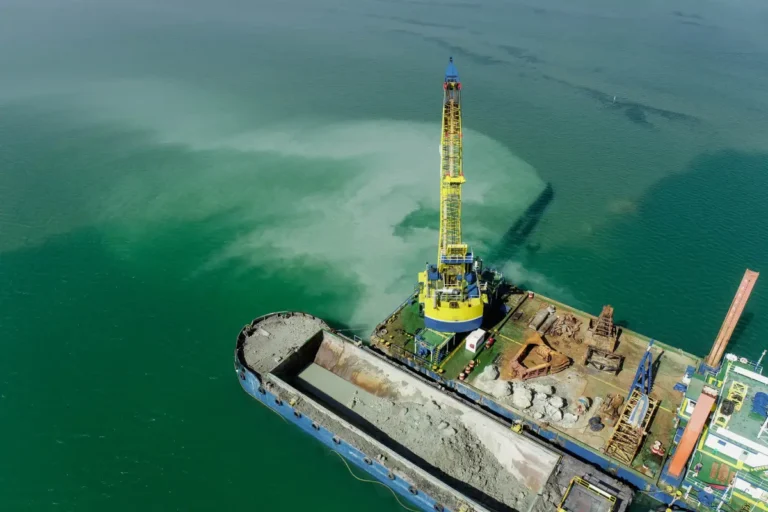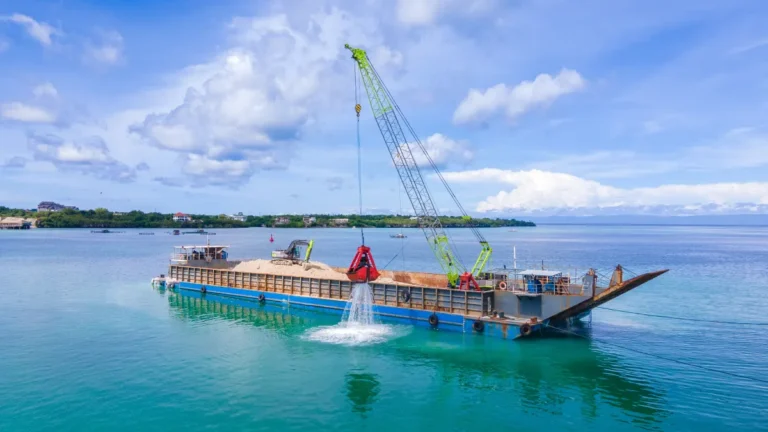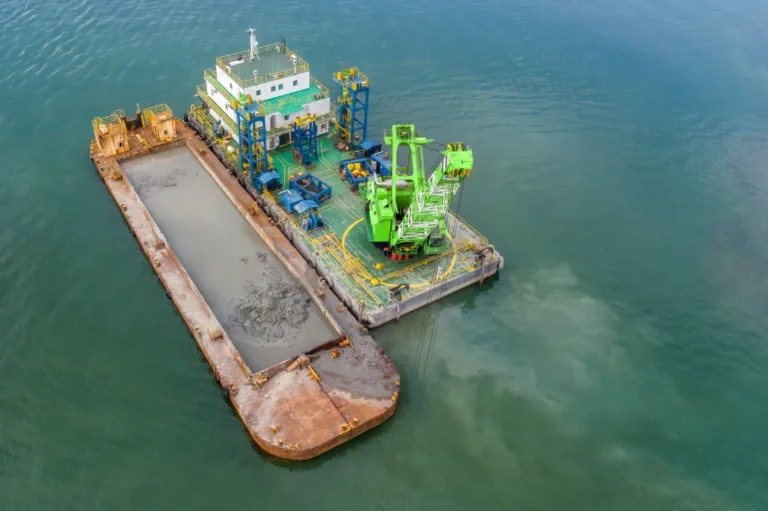Mechanical dredging is a sediment removal method that uses heavy machinery to excavate and transport materials from the bottom of waterways, ports, and other bodies of water. Unlike hydraulic dredging, which relies on suction to move fine-grained sediment, mechanical dredging physically scoops or digs sediment using specialized equipment such as clamshell dredges, backhoe dredges, and bucket ladder dredges. Clamshell dredges use a hinged bucket for targeted excavation of heavy or coarse material, backhoe dredges offer precision and flexibility in confined areas, and bucket ladder dredges continuously lift sediment with a rotating chain of buckets, making them ideal for high-volume projects. Mechanical dredging is particularly effective for removing compacted or coarse materials like gravel, rocks, and debris, providing superior accuracy and control in ports, harbors, and shallow waterways. Sediment accumulation can lead to reduced navigability, increased flooding risk, and environmental degradation, disrupting port operations and aquatic ecosystems. Mechanical dredging helps maintain safe navigation, improve water flow, and reduce contamination by safely removing and disposing of polluted sediments. This blog explores effective strategies for material handling in mechanical dredging, focusing on improving project efficiency, reducing costs, and minimizing environmental impact. It also highlights the advantages of mechanical dredging over hydraulic dredging, demonstrating how mechanical dredging excels in handling coarse, heavy, and contaminated materials with greater precision. Understanding the differences between hydraulic vs mechanical dredging will help project managers choose the best approach for their specific dredging requirements.
Understanding Mechanical Dredging
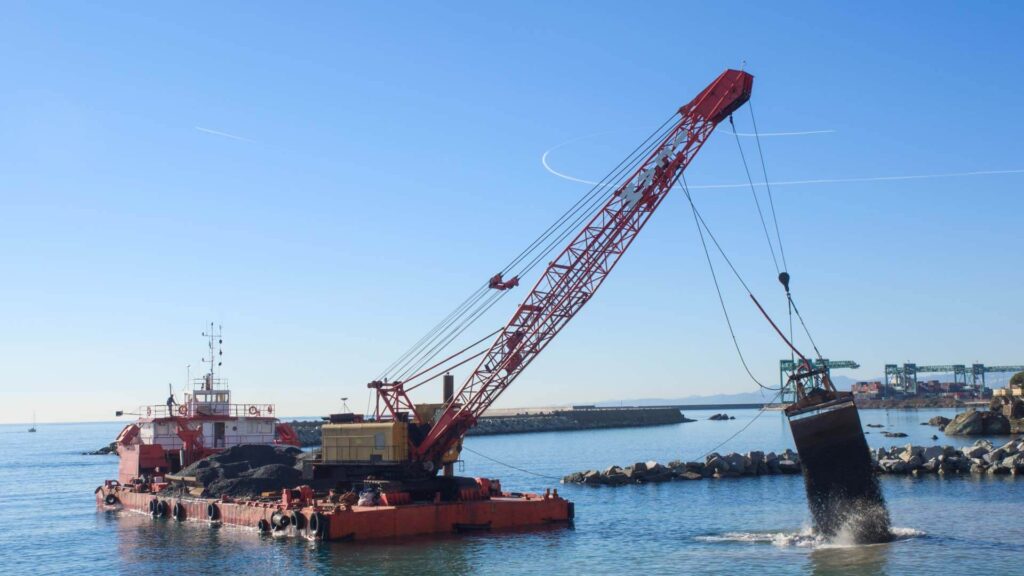
How Mechanical Dredging Works
Mechanical dredging involves excavating and removing sediment from the seabed, riverbed, or other underwater areas using heavy machinery. This method is widely used in ports, harbors, and inland waterways, where sediment buildup can restrict navigation and impact infrastructure. Unlike hydraulic dredging, which relies on suction, mechanical dredging physically lifts sediment using specialized equipment, making it more effective for handling coarse, consolidated, and contaminated materials.
The key equipment used in mechanical dredging includes:
Clamshell Dredges – Clamshell dredges use a large, hinged bucket (clamshell) to scoop sediment from the bottom of the waterway. The clamshell is lowered into the sediment, closed around the material, and lifted to the surface. This method is ideal for precision dredging in confined areas and for handling coarse materials such as sand, gravel, and rock. Clamshell dredging also minimizes sediment disturbance, which helps reduce turbidity and environmental impact.
Backhoe Dredges – Backhoe dredges consist of a large excavator mounted on a floating barge. The backhoe arm is extended into the water to dig and lift sediment using a bucket attachment. Backhoe dredging provides excellent precision and control, making it suitable for shallow water and areas with limited space. Its ability to handle large, heavy debris and compacted sediment makes it an efficient choice for targeted dredging operations.
Bucket Ladder Dredges – A bucket ladder dredge features a continuous chain of buckets mounted on a rotating ladder. As the ladder moves, the buckets scoop sediment from the seabed and transport it to the surface. This method is highly effective for large-scale dredging projects that require continuous excavation. Bucket ladder dredges are especially useful for removing heavy materials and maintaining consistent dredging depth over extended periods.
The mechanical dredging process typically involves the following:
- Positioning the dredge at the designated site.
- Lowering the dredging equipment (clamshell, backhoe, or bucket ladder) into the sediment.
- Excavating the sediment and lifting it to the surface.
- Transferring the sediment to a barge or other transport system for disposal or reuse.
- Repeat the process until the targeted area is cleared of sediment.
Advantages of Mechanical Dredging
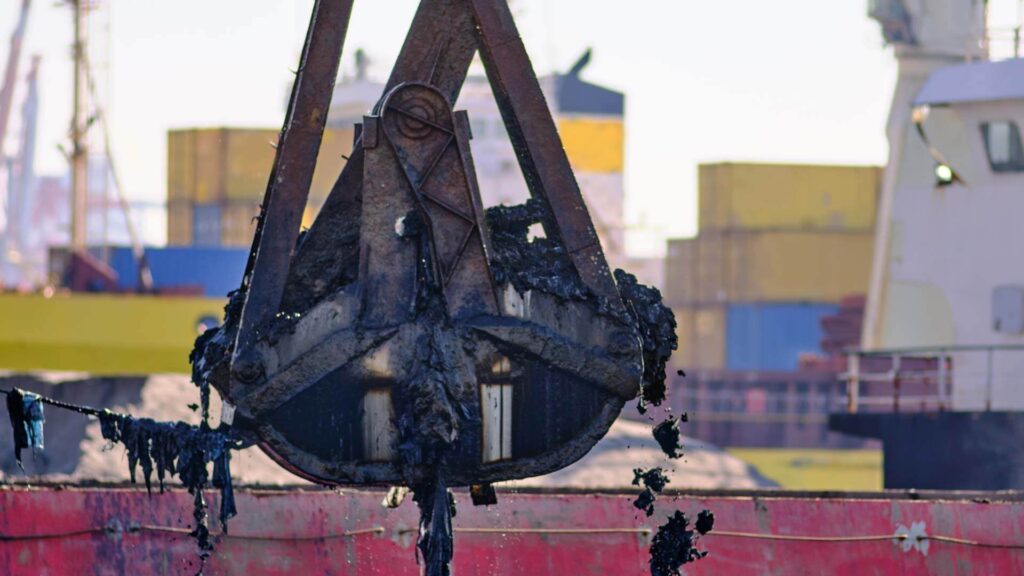
Several advantages of mechanical dredging make it the preferred method for certain dredging projects:
- Effective for removing heavy or coarse material—Mechanical dredging excels at handling coarse and compacted materials such as sand, gravel, and rock. Its ability to lift heavy debris directly from the seabed gives it a distinct advantage over hydraulic dredging in areas with tough sediment.
- Greater precision in dredging operations – Mechanical dredging allows for targeted excavation, enabling operators to remove sediment with high accuracy. This is particularly valuable in ports and harbors where precise depth and slope adjustments are required.
- Suitable for shallow water and confined spaces – Because mechanical dredging equipment can be mounted on barges or smaller platforms, it is well-suited for working in narrow channels, near infrastructure, and in shallow water where larger hydraulic dredges may not be practical.
- Easier handling of contaminated sediments—Mechanical dredging offers better control over sediment removal, minimizing disturbance to surrounding materials. Thus, it is easier to manage and safely dispose of contaminated sediments without risking further environmental harm.
Hydraulic vs. Mechanical Dredging
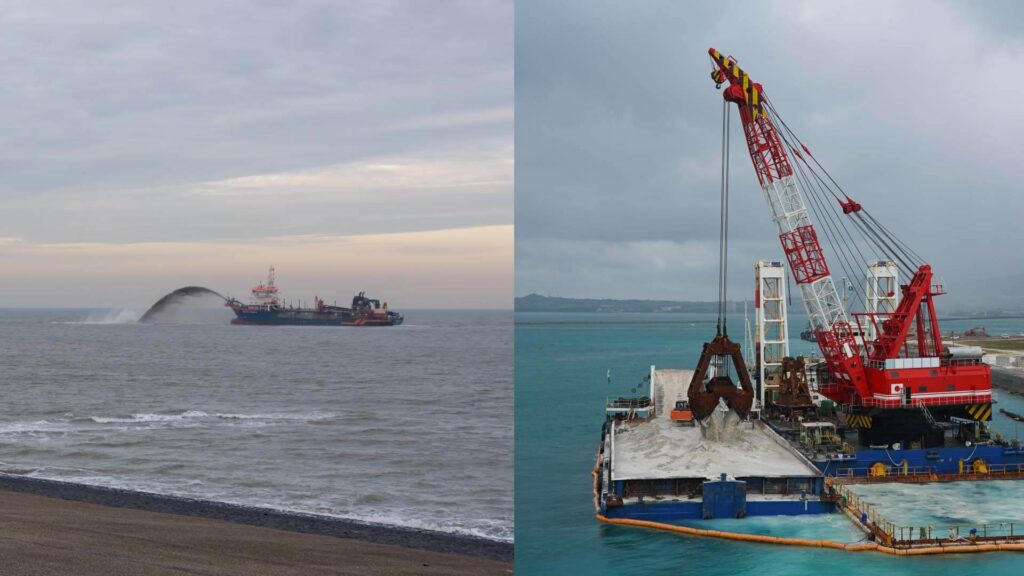
Understanding the differences between hydraulic and mechanical dredging is essential when choosing the right dredging method for a project.
Hydraulic Dredging
Hydraulic dredging uses suction to lift sediment from the bottom of the waterway. A high-powered pump generates suction, drawing fine-grained materials such as silt and mud into a pipeline. The pipeline then transports the sediment to a designated disposal site. Hydraulic dredging is highly efficient for large-scale projects involving loose or fine sediment.
- Higher production rates—Hydraulic dredging can quickly move large volumes of fine sediment, making it ideal for projects focused on material displacement rather than precision.
- Less effective with coarse or compacted materials – Hydraulic dredging is less effective when dealing with heavy materials like sand, gravel, and rock. It also struggles with removing debris or consolidated sediment.
Mechanical Dredging
Mechanical dredging, in contrast, is better suited for targeted excavation and handling of coarse or consolidated materials. It provides greater control over the dredging process, allowing operators to remove specific sediment layers without disturbing surrounding materials.
- Ideal for targeted, precise excavation, Mechanical dredging equipment allows for the selective removal of sediment, making it suitable for maintenance dredging and channel deepening.
- More effective for heavy, consolidated materials – Unlike hydraulic dredging, mechanical dredging can lift large, dense materials and debris directly from the seabed.
Choosing the Right Method
Selecting between hydraulic vs mechanical dredging depends on several factors:
- Sediment Type – Hydraulic dredging is better for fine-grained materials like silt and mud, while mechanical dredging excels with coarse and compacted materials.
- Environmental Impact – Mechanical dredging reduces turbidity and sediment disturbance, which helps protect aquatic ecosystems.
- Project Scale and Depth – Hydraulic dredging offers faster production rates for large-scale projects, while mechanical dredging provides better precision for smaller, targeted dredging jobs.
- Disposal Methods – Mechanical dredging allows for easier handling and containment of contaminated materials, making it suitable for projects requiring environmental compliance.
Strategies for Efficient Material Handling in Mechanical Dredging
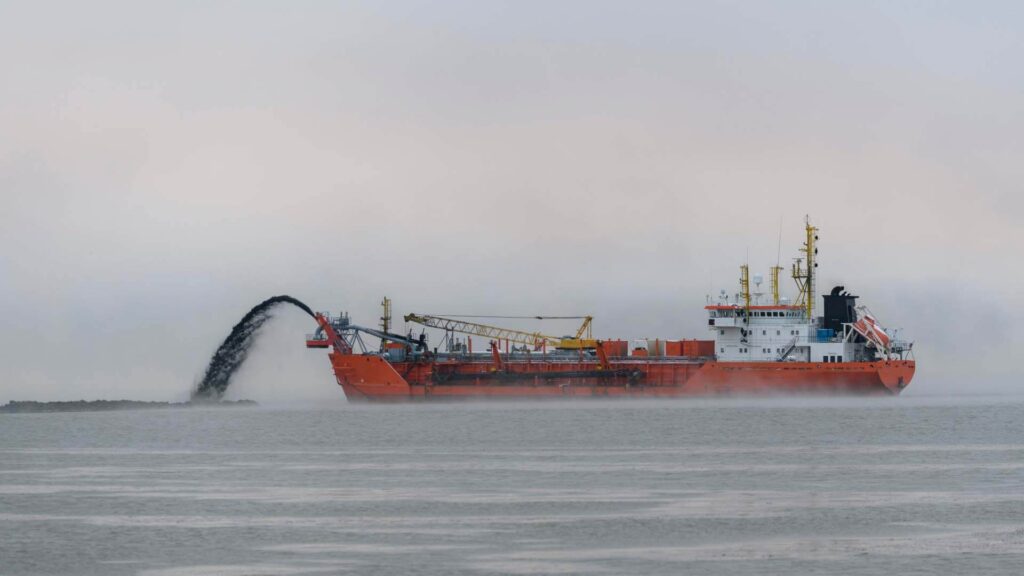
Pre-Dredging Planning and Site Assessment
Efficient mechanical dredging begins with thorough pre-dredging planning and site assessment. Before any dredging operation starts, it is crucial to conduct a detailed analysis of the site to determine the composition and volume of sediment, environmental impact, and logistical requirements.
Conducting geotechnical surveys is essential to understand the type of sediment being removed. Coarse materials such as sand, gravel, and rock require different dredging techniques and equipment than fine-grained sediment like silt and clay. Surveys also help identify potential challenges, such as hard layers, debris, or contaminated material that could complicate the dredging process.
Environmental impact assessments (EIAs) are also a key part of the pre-dredging process. While mechanical dredging is more controlled than hydraulic dredging, it can still affect water quality and marine life if not properly managed. Evaluating potential risks and developing mitigation strategies helps ensure compliance with environmental regulations and minimizes disruption to aquatic ecosystems.
Strategic route and disposal site planning improves the overall efficiency of mechanical dredging operations. Identifying the shortest and safest transport routes for dredged material reduces handling time and costs. Designating appropriate disposal or reuse sites also helps prevent delays and ensures environmental safety when handling contaminated sediment.
Equipment Selection and Optimization
Selecting the right dredging equipment is critical to the success of a mechanical dredging project. The type of sediment, depth of excavation, and site conditions all influence the choice of dredge.
Clamshell dredges are ideal for precise excavation in harbors, ports, and confined spaces. They excel at handling coarse material,l such as gravel and rock while minimizing sediment disturbance. Clamshell dredges are particularly effective when removing contaminated material, as they provide greater control over sediment excavation and handling.
Backhoe dredges are better suited for shallow water operations and targeted excavation. They offer greater mobility and precision, making them ideal for projects that require specific depth and slope adjustments. Backhoe dredges are also effective at handling consolidated materials and debris that may be difficult for hydraulic dredging methods to manage.
The size of the bucket and the efficiency of the dredging cycle directly impact project productivity. Larger buckets allow for higher sediment removal rates but may require more powerful support equipment. Smaller buckets offer better precision and control, especially in confined areas or near sensitive infrastructure.
Support equipment such as barges and cranes is essential for efficient material handling. Barges transport dredged material from the excavation site to the disposal or processing location. Cranes lift and load sediment, increasing the overall efficiency of the dredging operation. Optimizing the coordination between dredging and transport equipment minimizes downtime and maximizes output.
Efficient Sediment Removal Techniques
Efficient sediment removal in mechanical dredging requires minimizing disturbance to the surrounding environment while maximizing excavation speed and accuracy.
Minimizing turbidity and sediment resuspension is critical to maintaining water quality and protecting marine life. Clamshell and backhoe dredges allow for controlled excavation, reducing the amount of fine sediment released into the water column. Sediment curtains and other containment methods help further limit the spread of disturbed material.
Modern positioning and GPS systems improve dredging accuracy, ensuring that the excavation area is precisely targeted. This reduces the need for repeat passes and helps avoid over- or under-dredging. Accurate positioning also streamlines the dredging process, reducing fuel consumption and operational costs.
Optimizing dredge cycles involves coordinating excavation, lifting, and transport to minimize downtime between cycles. Adjusting the dredging pattern based on sediment composition and equipment capacity helps maintain consistent removal rates and reduces wear on dredging components.
Handling and Transport of Dredged Material
Efficient handling and transport of dredged material are essential for maintaining project timelines and minimizing costs. Mechanical dredging produces bulk material that must be safely transported to a disposal or processing site.
Barges are commonly used for transporting dredged material over water. They offer high load capacity and flexibility for large-scale dredging projects. For inland or small-scale projects, trucks or pipelines may be used to transport material to disposal or treatment sites. The choice of transport method depends on the project scale, site accessibility, and environmental regulations.
Implementing best practices for material containment prevents spillage and contamination during transport. Lined barges and sealed containers help prevent sediment from washing into the water. Proper handling procedures also minimize the release of dust and debris during loading and unloading.
Obtaining the necessary permits for material transport and disposal ensures compliance with local and international regulations. Proper documentation and adherence to environmental standards help avoid fines and project delays. Regulatory agencies may require testing of dredged material for contaminants, which determines whether the material can be reused, processed, or disposed of in a controlled facility.
Strategies for Sediment Disposal

Effective sediment disposal is a critical component of mechanical dredging operations. Once sediment has been excavated and transported, it must be properly managed to comply with environmental regulations and minimize project costs. Sediment disposal strategies depend on the type of material, contamination levels, and the intended use or containment method. The goal is to handle dredged material in a way that is safe, efficient, and environmentally responsible.
Onshore vs. Offshore Disposal
The choice between onshore and offshore disposal depends on the type and volume of dredged material, environmental impact, and regulatory requirements. Both methods have specific advantages and challenges that influence project outcomes.
Offshore disposal involves transporting dredged material to designated dumping zones in open water. This method is typically used when the material is clean and environmentally safe. Offshore disposal is common in large-scale dredging projects where onshore disposal is not practical due to space or logistical constraints. However, it requires permits and environmental assessments to ensure it does not harm marine ecosystems or disrupt shipping lanes.
Onshore disposal is often preferred when dredged material contains contaminants or can be repurposed for beneficial purposes. Sediment is transported to sediment basins, land reclamation sites, or specially designated containment areas. Onshore disposal offers better control over sediment containment and reduces the risk of environmental contamination. It also allows for processing or treating the material before reuse.
When considering hydraulic vs mechanical dredging, mechanical dredging provides greater flexibility for sediment disposal since the material is excavated in a solid state rather than a slurry. This makes it easier to transport and store, especially for onshore disposal. Mechanical dredging also minimizes the risk of sediment dispersion during offshore disposal, which can help protect marine ecosystems.
Environmental Considerations
Environmental responsibility is a key factor in sediment disposal during mechanical dredging. Improper disposal can lead to water pollution, habitat destruction, and long-term environmental damage. Careful testing and planning help minimize these risks and ensure compliance with environmental regulations.
Testing sediment for contamination is essential before disposal. Dredged material may contain pollutants such as heavy metals, hydrocarbons, and industrial waste, which can pose a threat to marine and terrestrial ecosystems. Contaminated sediment may require special handling and disposal in licensed facilities or treatment before reuse.
Preventing the spread of invasive species is another important consideration. Dredged material can harbor invasive plants, animals, or pathogens that may disrupt local ecosystems if introduced into new areas. Proper handling and containment of sediment reduce the risk of spreading harmful species.
Meeting local and international environmental regulations is critical for project approval and successful execution. Environmental agencies often require detailed disposal plans, impact assessments, and sediment testing results. Ensuring that disposal methods align with these requirements helps avoid legal complications and project delays.
Reuse and Recycling of Dredged Material
Reusing dredged material is an environmentally sustainable and cost-effective alternative to disposal. Mechanical dredging produces solid material that can be repurposed for various construction and restoration projects. This reduces waste and generates value from sediment removal.
Dredged material is most commonly used for land reclamation and coastal restoration. Sediment can be used to create new land for development, reinforce shorelines, and restore eroded beaches. The stability and composition of mechanically dredged material make it ideal for creating durable landforms and improving coastal resilience.
The use of dredged sand and gravel in construction provides a valuable source of raw material for concrete production, roadbeds, and fill. Mechanically dredged material is often cleaner and more uniform than hydraulically dredged sediment, making it more suitable for construction applications. Using dredged material in construction reduces the need for mining and quarrying, which helps conserve natural resources.
Ecological restoration and habitat enhancement involve using dredged material to create or restore wetlands, estuaries, and underwater habitats. Mechanically dredged sediment can be strategically placed to rebuild marshes, create fish habitats, and support aquatic plant growth. This not only benefits the environment but also enhances local biodiversity and ecosystem health.
Mechanical dredging has significant advantages in sediment reuse. Unlike hydraulic dredging, which produces a slurry that requires dewatering and processing, mechanically dredged material can be immediately used for construction or restoration projects. This reduces handling time and costs while maximizing the value of the dredged material.
Challenges and Solutions in Mechanical Dredging
Environmental Impact
Environmental impact is one of the most significant challenges in mechanical dredging. Excavating sediment from the seabed or riverbed can disturb the surrounding ecosystem, affecting water quality, marine life, and coastal stability. Proper environmental impact management is essential to maintaining project sustainability and meeting regulatory requirements.
Managing water quality and turbidity is a key concern in mechanical dredging. When sediment is disturbed, fine particles can become suspended in the water column, increasing turbidity and reducing water clarity. This can disrupt the feeding and breeding patterns of aquatic species and lead to oxygen depletion. To reduce turbidity, operators can use silt curtains and containment barriers to prevent the spread of suspended sediment. Additionally, precise dredging techniques and controlled excavation speeds help minimize sediment disturbance.
Another challenge is reducing noise and disturbance to marine life. Mechanical dredging equipment, such as clamshell and backhoe dredges, generates underwater noise that can disrupt marine species, particularly those that rely on sound for navigation and communication. To mitigate this, operators can use sound-reducing technologies, limit dredging hours to avoid sensitive breeding periods and monitor marine activity to adjust operations accordingly. Proper positioning of dredging equipment and careful handling of sediment also help reduce environmental stress on aquatic ecosystems.
Mechanical dredging offers several advantages over hydraulic dredging in terms of environmental impact. Unlike hydraulic dredging, which can create large sediment plumes and increase turbidity over a wide area, mechanical dredging allows for more localized and controlled excavation. This reduces the spread of sediment and minimizes disruption to the surrounding environment.
Equipment Downtime and Maintenance
Maintaining dredging equipment in optimal working conditions is critical for efficient mechanical dredging. Equipment downtime can lead to project delays, increased costs, and missed production targets. Mechanical dredging equipment, including clamshells, backhoes, and bucket ladder dredges, operates in harsh marine environments, which increases the risk of wear and tear.
Regular maintenance of dredge components is essential to prevent unexpected breakdowns and extend the equipment’s lifespan. Dredge buckets, cables, hydraulic systems, and mechanical arms should be inspected regularly for signs of wear, corrosion, and structural damage. Preventative maintenance schedules help identify and address potential issues before they cause equipment failure.
Monitoring wear and tear on buckets and cables ensures consistent dredging performance. Buckets are exposed to abrasive materials such as gravel and rocks, which can cause rapid degradation. Replacing worn buckets and reinforcing cable connections help maintain the accuracy and efficiency of dredging operations. Additionally, lubricating moving parts and checking hydraulic systems prevent mechanical failure and improve overall performance.
Mechanical dredging provides advantages over hydraulic dredging in terms of equipment maintenance. Hydraulic systems are prone to clogging and wear from fine sediment and debris, which can reduce suction efficiency. In contrast, mechanical dredging equipment is designed to handle heavier and more abrasive materials, making it more durable and easier to maintain in challenging conditions.
Regulatory and Permitting Issues
Navigating complex permitting processes and meeting environmental regulations are major challenges in mechanical dredging. Dredging projects are subject to strict oversight from local, national, and international regulatory bodies to protect marine ecosystems and maintain water quality.
Navigating complex permitting processes requires a detailed understanding of environmental laws and regulatory requirements. Permits are often required for sediment removal, transport, and disposal, and the approval process can be time-consuming. Failure to obtain the proper permits can lead to project delays, fines, and legal action. Working with environmental consultants and regulatory agencies helps streamline the permitting process and ensures all requirements are met.
Ensuring compliance with environmental standards involves adhering to guidelines for water quality, sediment disposal, and ecosystem protection. Mechanical dredging provides greater control over sediment removal and handling, which helps meet regulatory requirements more easily. For example, mechanical dredging produces less sediment plumes and turbidity than hydraulic dredging, reducing the risk of violating water quality standards.
Mechanical dredging offers regulatory compliance advantages over hydraulic dredging. The ability to control the excavation process more precisely reduces environmental impact, making it easier to meet permit conditions and avoid costly delays. By implementing best practices for sediment handling and environmental protection, mechanical dredging projects can operate more efficiently within the framework of existing regulations.
Future Trends in Mechanical Dredging
Automation and Remote Operation
Advancements in automation and remote operation are shaping the future of mechanical dredging. Emerging technologies such as artificial intelligence (AI), machine learning, and remote control systems are transforming the dredging industry by increasing efficiency, precision, and safety.
AI and machine learning are being integrated into mechanical dredging equipment to optimize excavation patterns and improve dredging accuracy. Machine learning algorithms analyze real-time data on sediment composition, water depth, and environmental conditions to adjust dredging techniques automatically. This allows operators to maximize material removal while minimizing disruption to the surrounding environment. AI-driven systems can also predict equipment wear and schedule maintenance, reducing downtime and extending the lifespan of dredging components.
Remote monitoring and control are improving operational efficiency and safety in mechanical dredging. Modern dredging equipment is equipped with GPS, sonar, and real-time video feeds that allow operators to control and monitor dredging operations from a remote location. This reduces the need for personnel on-site and enhances the ability to respond to changing environmental conditions or equipment issues. Remote operation also increases dredging accuracy by allowing operators to make real-time adjustments based on sediment feedback and positioning data.
The advantages of mechanical dredging in terms of automation are significant compared to hydraulic dredging. Hydraulic dredging relies heavily on the efficiency of pumps and pipelines, which can be affected by sediment consistency and environmental factors. In contrast, mechanical dredging benefits from direct control over the excavation process, which allows AI and machine learning systems to adapt more effectively to site-specific conditions. Automation enhances the precision and speed of mechanical dredging while reducing labor costs and improving overall project efficiency.
Eco-Friendly Dredging Solutions
Sustainability is becoming a major focus in the dredging industry, driving the development of eco-friendly mechanical dredging solutions. As environmental regulations become more stringent and the impact of climate change on coastal infrastructure increases, the demand for low-impact dredging technologies is growing.
The development of low-impact dredging technologies is helping to reduce mechanical dredging’s environmental footprint. Equipment manufacturers are designing dredges with improved fuel efficiency and reduced emissions. Electric and hybrid dredging equipment is becoming more widely available, providing a cleaner alternative to traditional diesel-powered systems. Low-turbidity clamshells and specialized bucket designs are also being developed to minimize sediment disturbance and protect water quality.
Focus on reducing carbon footprint and improving energy efficiency is driving innovation in dredging equipment and operations. Modern mechanical dredging equipment is being equipped with energy-efficient hydraulic systems and automated load-balancing technology to reduce fuel consumption. Advanced dredging techniques, such as precision excavation and optimized dredge cycles, are helping to minimize energy use and maximize productivity.
Mechanical dredging offers environmental advantages over hydraulic dredging in terms of energy consumption and sediment control. Hydraulic dredging requires continuous pumping and processing of water and sediment, which can be energy-intensive and lead to higher emissions. In contrast, mechanical dredging involves targeted excavation and material transport, which reduces overall energy demand and limits sediment resuspension. By adopting eco-friendly equipment and practices, mechanical dredging projects can meet environmental standards while reducing operational costs.
Conclusion
Mechanical dredging remains a highly effective method for sediment removal, offering distinct advantages over hydraulic dredging in terms of precision, efficiency, and material handling. By leveraging advanced equipment and optimized dredging techniques, mechanical dredging provides greater control over sediment removal, making it ideal for handling coarse and contaminated materials. Effective planning, equipment selection, and sediment disposal strategies are key to maximizing the benefits of mechanical dredging while minimizing environmental impact. As the industry evolves, innovations in automation, AI, and eco-friendly technologies will continue to enhance the efficiency and sustainability of mechanical dredging, ensuring it remains a critical solution for maintaining waterways, ports, and coastal infrastructure.


